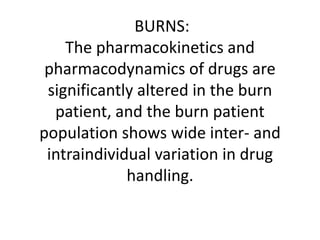ppt.pptx
•
0 likes•4 views
ppt• protein binding, drug distribution and clearance may be altered. • Because of the alteration in these variables, wide intraindividual variation of pharmacokinetic parameters occurs depending upon the time since thermal injury and fluid resuscitation. • Interindividual variations may be correlated with the percentage of the body surface area that is burnt,
Report
Share
Report
Share
Download to read offline

Recommended
More Related Content
Similar to ppt.pptx
Similar to ppt.pptx (20)
Therapeutic Drug Monitoring (TDM) | Criteria and Indications of TDM | Why TDM...

Therapeutic Drug Monitoring (TDM) | Criteria and Indications of TDM | Why TDM...
Clinical Trials,Hypersenstivity,types of drug interactions.pptx

Clinical Trials,Hypersenstivity,types of drug interactions.pptx
ppt.pptx
- 1. BURNS: The pharmacokinetics and pharmacodynamics of drugs are significantly altered in the burn patient, and the burn patient population shows wide inter- and intraindividual variation in drug handling.
- 2. • Burn injury evolves in two phases. • The first phase corresponds to the burn shock, which occurs during the first 48 hours after thermal injury.
- 3. In this phase, hypovolaemia, oedema, hypoalbuminaemia and a low glomerular filtration rate are observed, which result in a slower rate of drug distribution and lower renal clearance.
- 4. • The second phase (beyond 48 hours after injury) is a hyperdynamic state with high blood flow in the kidneys and liver, an increased α1-acid-glycoprotein level and loss of the drug with exudate leakage. As a result, protein binding, drug distribution and clearance may be altered.
- 5. • protein binding, drug distribution and clearance may be altered. • Because of the alteration in these variables, wide intraindividual variation of pharmacokinetic parameters occurs depending upon the time since thermal injury and fluid resuscitation. • Interindividual variations may be correlated with the percentage of the body surface area that is burnt,